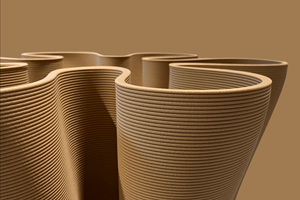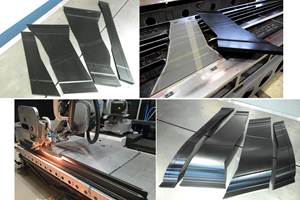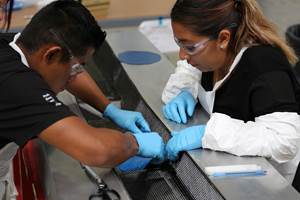Tooling foam, core excels in uniformity, high temps and repeated curing
CAMX 2024: General Plastics Manufacturing Co. returns with advancements to its Last-a-Foam tooling board foam and composite core products.
Share
General Plastics Manufacturing Co. (Tacoma, Wash., U.S.), a provider and manufacturer of rigid and flexible polyurethane foam sheet stock, built-to-print composite assemblies and finished custom parts, is exhibiting the latest advancements to its Last-a-Foam high-temperature tooling board foam and composite core products.
Last-a-Foam tooling board provides aerospace, automotive, marine and other composites manufacturing companies with a high-performance, consistently uniform material that can withstand high temperatures and repeated curing cycles. Affordable and dimensionally stable, this rigid foam board is ideal for prototype machining, high-temperature curing prepregs, vacuum forming, pattern making and other limited-run tooling where traditional metal dies are cost-prohibitive.
Available in 3-50-pound densities, this series is non-abrasive, can be machined with standard high-speed steel cutting tools into complex shapes and is available in custom sizes. It can also be cut cleanly with waterjets and traditional wood-carving tools. General Plastics also offers complete in-house production services that deliver tools machined to final specifications.
According to the company, Last-of-Foam core is renowned for its high strength, low weight and consistent properties. Its formulations are reported to offer a compelling alternative to traditional core materials, such as thermoplastic foam, honeycomb, wood and metal. General Plastics’ closed-cell, water-resistant core materials meet the requirements of numerous industries and complex applications such as FST/OSU-compliant foam core in aircraft interior sandwich panels; high strength-to-weight ratio core material for automotive load floors; dielectric material for radomes; buoyancy foam in subsea applications; and even impact-resistant core in hockey sticks.
General Plastics recently released a new composite core technical paper, which examines the factors to consider when choosing a core material for an application, which is available at www.generalplastics.com.
Related Content
-
Sulapac introduces Sulapac Flow 1.7 to replace PLA, ABS and PP in FDM, FGF
Available as filament and granules for extrusion, new wood composite matches properties yet is compostable, eliminates microplastics and reduces carbon footprint.
-
Plant tour: Airbus, Illescas, Spain
Airbus’ Illescas facility, featuring highly automated composites processes for the A350 lower wing cover and one-piece Section 19 fuselage barrels, works toward production ramp-ups and next-generation aircraft.
-
3D-printed CFRP tools for serial production of composite landing flaps
GKN Aerospace Munich and CEAD develop printed tooling with short and continuous fiber that reduces cost and increases sustainability for composites production.
Related Content
Sulapac introduces Sulapac Flow 1.7 to replace PLA, ABS and PP in FDM, FGF
Available as filament and granules for extrusion, new wood composite matches properties yet is compostable, eliminates microplastics and reduces carbon footprint.
Read MorePlant tour: Airbus, Illescas, Spain
Airbus’ Illescas facility, featuring highly automated composites processes for the A350 lower wing cover and one-piece Section 19 fuselage barrels, works toward production ramp-ups and next-generation aircraft.
Read More3D-printed CFRP tools for serial production of composite landing flaps
GKN Aerospace Munich and CEAD develop printed tooling with short and continuous fiber that reduces cost and increases sustainability for composites production.
Read MoreComposites manufacturing for general aviation aircraft
General aviation, certified and experimental, has increasingly embraced composites over the decades, a path further driven by leveraged innovation in materials and processes and the evolving AAM market.
Read MoreRead Next
ATL Composites collaboration advances kite-foil board production for Paris Olympics
Breiana Whitehead, pioneering Australian kite-foil sailor, spearheads board design intricacies with ATL Composites to enhance her performance ahead of the July 2024 competition.
Read MoreAssembling the Multifunctional Fuselage Demonstrator: The final welds
Building the all-thermoplastic composite fuselage demonstrator comes to an end with continuous ultrasonic welding of the RH longitudinal fuselage joint and resistance welding for coupling of the fuselage frames across the upper and lower halves.
Read MoreAll-recycled, needle-punched nonwoven CFRP slashes carbon footprint of Formula 2 seat
Dallara and Tenowo collaborate to produce a race-ready Formula 2 seat using recycled carbon fiber, reducing CO2 emissions by 97.5% compared to virgin materials.
Read More










